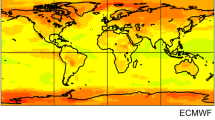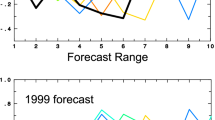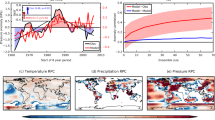Abstract
The “potential predictability” of the climate system is the upper limit of available forecast skill and can be characterized by the ratio p of the predictable variance to the total variance. While the potential predictability of the actual climate system is unknown its analog q may be obtained for a model of the climate system. The usual correlation skill score r and the mean square skill score M are functions of p in the case of actual forecasts and potential correlation ρ and potential mean square skill score \(\mathcal{M}\) are the same functions of q in the idealized model context. In the large ensemble limit the connection between model-based potential predictability and skill scores is particularly straightforward with \(q=\rho^{2}=\mathcal{M}.\) Decadal predictions of annual mean temperature produced with the Canadian Centre for Climate Modelling and Analysis coupled climate model are analyzed for information on decadal climate predictability and actual forecast skill. Initialized forecast results are compared with the results of uninitialized climate simulations. Model-based values of potential predictability q and potential correlation skill ρ are obtained and ρ is compared with the actual forecast correlation skill r. The skill of externally forced and internally generated components of the variability are separately estimated. As expected, ρ > r and both decline with forecast range τ, at least for the first five years. The decline of skill is associated mainly with the decline of the skill of the internally generated component. The potential and actual skill of a forecast of time-averaged temperature depends on the averaging period. The skill of uninitialized simulations is low for short averaging times and increases as averaging time increases. By contrast, skill is high at short averaging times for forecasts initialized from observations and declines as averaging times increase to about three years, then increases somewhat at longer averaging times. The skills of the initialized forecasts and uninitialized simulations begin to converge for longer averaging times. The potential correlation skill ρ of the externally forced component of temperature is largest at tropical latitudes and the skill of the internally generated component is largest over the North Atlantic, parts of the Southern Ocean and to some extent the North Pacific. Potential skill over extratropical land is somewhat weaker than over oceans. The distribution of actual correlation skill r is broadly similar to that of potential skill for the externally forced component but less so for the internally generated component. Differences in potential and actual skill suggest where improvements in the forecast system might be found.








Similar content being viewed by others
References
Arora VK, Scinocca JF, Boer GJ, Christian JR, Denman KL, Flato GM, Kharin VV, Lee W-S, Merryfield WJ (2011) Carbon emission limits required to satisfy future representative concentration pathways of greenhouse gases, Geophys Res Lett 38:L05805. doi:10.1029/2010GL04627
Behringer DW, Ji M, Leetmaa A (1998) An improved coupled model for ENSO prediction and implications for ocean initialization. Part I: the ocean data assimilation system. Mon Wea Rev 126:013–1021
Boer GJ (2000) A study of atmosphere–ocean predictability on long timescales. Clim Dyn 16:469–477
Boer GJ (2004) Long time-scale potential predictability in an ensemble of coupled climate models. Clim Dyn 23:29–44
Boer GJ, Lambert SJ (2008) Multi-model decadal potential predictability of precipitation and temperature. Geophys Res Lett 35:L05706. doi:10.1029/2008GL033234
Boer GJ (2011) Decadal potential predictability of twenty-first century climate. Clim Dyn 36:1119–1133
Branstator G, Teng H (2010) Two limits of initial-value decadal predictability in a CGCM. J Clim 23: 6292–6311
Branstator G, Teng H, Meehl G, Kimoto M, Knight J, Latif M, Rosati A (2011) Systematic estimates of initial value decadal predictability for six AOGCMS. J Clim. doi:10.1175/JCLI-D-11-00227.1
Collins M, M Allen (2002) Assessing the relative roles of initial and boundary conditions in interannual to decadal climate predictability. J Clim 15: 3104–3109
Collins M., Botzet M, Carril A, Drange H, Jouzeau A, Latif M, Ottera O, Pohlmann H, Sorteberg A, Sutton R, Terray L, (2006) Interannual to decadal climate predictability: a multimodel-ensemble study. J Clim 19:1195–1203
Dee DP, et al. (2011) The ERA-Interim reanalysis: configuration and performance of the data assimilation system. Quart J R Meteorol Soc 137:553–597
Fyfe JC, Merryfield WJ, Kharin V, Boer GJ, Lee W-S, von Salzen K (2011) Skillful predictions of decadal trends in global mean surface temperature. Geophys. Res Lett 38:L22801. doi:10.1029/2011GL049508
Griffies SM, Bryan K (1997) A predictability study of simulated North Atlantic multidecadal variability. Clim Dyn 13:459–488
Hansen J, Ruedy R, Sato M, Lo K (2010) Global surface temperature change. Rev Geophys 48:RG4004. doi:10.1029/2010RG000345
Jolliffe IT, Stephenson DB (2003) Forecast verification: a practitioner’s guide in atmospheric science. Wiley, Chichester
Keenlyside NS, Latif M, Jungclaus J, Kornblueh L, Roeckner E (2008) Advancing decadal-scale climate prediction in the North Atlantic sector. Nature 453:84–88. doi:10.1038/nature06921
Kharin VV, Boer GJ, Merryfield WJ, Scinocca JF, Lee W-S (2012) Statistical adjustment of decadal predictions in a changing climate. Geophys Res Lett 39:L19705. doi:10.1029/2012GL052647
Kim H-M, Webster P, Curry J (2012) Evaluation of short-term climate change prediction in multi-model CMIP5 decadal hindcasts. Geophys Res Lett 39. doi:10.10.29/2012GL051644
Merryfield WJ, Lee W-S, Boer GJ, Kharin VV, Scinocca JF, Flato GM, Ajayamohan RS, Fyfe JC, Tang Y, Polavarapu S (2013) The Canadian Seasonal to Interannual Prediction System. Part I: models and initialization. Mon Wea Rev. doi:10.1175/MWR-D-12-00216.1
Mochizuki T, Chikamoto T, Kimoto M, Ishii M, Tatebe H, Komuro Y, Sakamoto T, Watanabe M, Mori M (2012) Decadal prediction using a recent series of MIROC global climate models. J Met Soc Jpn 90:373–383
Murphy JM, et al. (2004) Quantification of modelling uncertainties in a large ensemble of climate change simulations. Nature 429:768–772
Pohlmann H., Botzet M, Latif M, Roesch A, Wild M, Tschuck P (2004): Estimating the decadal predictability of a coupled AOGCM. J Clim 17:4463–4472
Pohlmann H, Jungclaus J, Köhl A, Stammer D, Marotzke J (2009) Initializing decadal climate predictions with the GECCO oceanic synthesis: effect on the North Atlantic. J Clim 22:3926–3938
Power S, Colman R (2006) Multi-year predictability in a coupled general circulation model. Clim Dyn 26:2147–272
Rowell D. (1998) Assessing potential seasonal predictability with an ensemble of multidecadal GCM simulations. J Clim 11:109–120
Smith D, Cusack S, Colman A, Folland C, Harris G, Murphy J (2007) Improved surface temperature prediction for the coming decade from a global climate model. Science 317:796–799. doi:10.1126/science.1139540
Stainforth DA et al. (2005) Uncertainty in predictions of the climate response to rising levels of greenhouse gases. Nature 433:403–406
Stockdale T (1997) Coupled ocean—atmosphere forecasts in the presence of climate drift. Mon Wea Rev 125:809–818
Tang Y, Kleeman R, Moore AM, Vialard J, Weaver A (2004) An off-line, numerically efficient initialization scheme in an oceanic general circulation model for El Nino-Southern Oscillation prediction. J Geophys Res 109:C05 014
Taylor K, Stouffer R, Meehl G (2012) An overview of CMIP5 and the experiment design. Bull Am Meteorol Soc 93:485–498. doi:10.1175/BAMS-D-11-00094.1
Uppala SM, et al. (2005) The ERA-40 re-analysis. Quart J R Meteor Soc 131:2961–3012
van der Linden P, Mitchell J (eds) (2009) ENSEMBLES: climate change and its impacts: summary of research and results from the ENSEMBLES project. Met Office Hadley Centre, Fitzroy Road, Exeter EX1 3PB, UK
van Oldenborgh, Doblas-Reyes F, Wouters B, Hazeleger W (2012) Decadal prediction skill in a multi-model ensemble. Clim Dyn 38:1263–1280
von Storch H, Zwiers FW (1999) Statistical analysis in climate research. Cambridge University Press, Cambridge
Zwiers F, Kharin V (1998) Intercomparison of interannual variability and potential predictability: an AMIP diagnostic subproject. Clim Dyn 14:517-528
Acknowledgments
We especially acknowledge Woo-Sung Lee for her very important contribution to the project. Two anonymous referees also helped to improve the paper.
Author information
Authors and Affiliations
Corresponding author
Appendix
Appendix
The statistical assumptions made and the estimates of the population parameters that enter the expressions are reviewed here. Estimates apply at forecast range τ so this subscript is omitted. Retaining subscripts f and i, which identify the forced and internally generated components, the observations, forecasts and simulations are represented as
where, as before, α labels the ensemble member and j labels the start date (and applies to all terms within the brackets).
1.1 Statistical assumptions
The population parameters for the observations and forecasts are assumed to consist of a mean, a deterministic externally forced component, and the remaining potentially predictable and noise components in the form Y = ν + ψ f + ψ i + y. The assumed statistical relationships are indicated by the expectations of the various first and second order terms that arise. For the forecasts these are
for ϱ(j − k) the lagged autocorrelation of ψ i . Results are also similar for the simulations U where, however, \(E\varphi_{i,\alpha j}\varphi_{i,\beta k}=\delta_{\beta}^{\alpha}\sigma_{\varphi_{i}}^{2}{\varrho_{\varphi_{i}}}(j-k)\) since the internally generated component is independent from one ensemble member to another in that case. The relationships for products of observed with forecast and simulated terms are indicated by
1.2 Sample statistics
Estimates of the population variances and covariances are obtained from sample variances and covariances. The simplified notation in Sect. 4 is used, the mean over all start dates is indicated by an overbar, and the mean over all ensemble members is represented by braces as
Second order sample statistics are obtained as
where
The sample statistics are used to estimate the population parameters in (3).
The expectations of these statistics follow, for example, as
where the deterministic forced component has zero mean when averaged over all start dates, i.e. \(\overline{\psi}_{f}=\frac{1}{n}\sum\nolimits_{j}\psi_{f,j}=0, \) and where cross-product terms vanish following (10). The other quantities are evaluated similarly with
and
where
and \(\gamma=1+2\sum\nolimits_{l=1}^{n}(1-\frac{l}{n})\varrho(l)=1+\epsilon\) (e.g. Boer 2004).
For the simulations
For cross-products
and
Expected values of the sample statistics follow as
1.3 Statistical estimates of variances and covariances
Unbiased estimates, indicated by carets, of the variances and covariances for the forecasts follow with
and the unbiased estimate for σ 2ψ is obtained as an approximation with
For \(\epsilon\) generally <2 as seen in Boer (2004), the neglected term \(\xi=-(\frac{1}{n-1})(\sigma_{\psi_{f}}^{2} -\epsilon\sigma_{\psi_{i}}^{2})\) is a small fraction of the total with
for n = 40 as is the case here. Similarly
and for the simulations
As noted in the text, Covχ i ψ i is loosely approximated by taking \(Cov\chi_{f}\psi_{f}\approx Cov\chi_{f}\varphi_{f}\) whence
and, finally,
Rights and permissions
About this article
Cite this article
Boer, G.J., Kharin, V.V. & Merryfield, W.J. Decadal predictability and forecast skill. Clim Dyn 41, 1817–1833 (2013). https://doi.org/10.1007/s00382-013-1705-0
Received:
Accepted:
Published:
Issue Date:
DOI: https://doi.org/10.1007/s00382-013-1705-0




